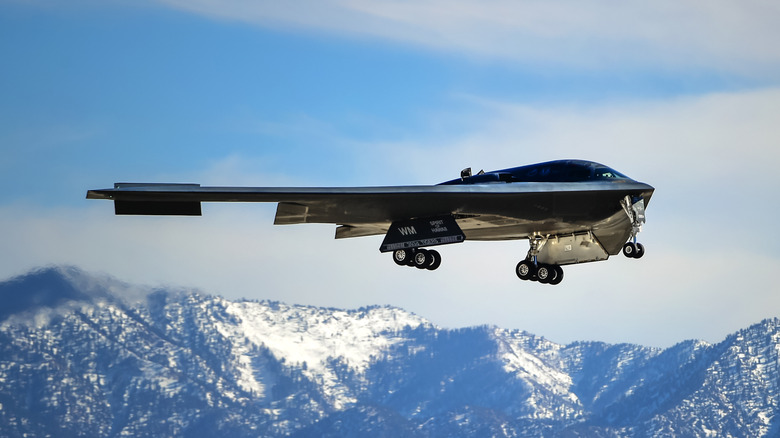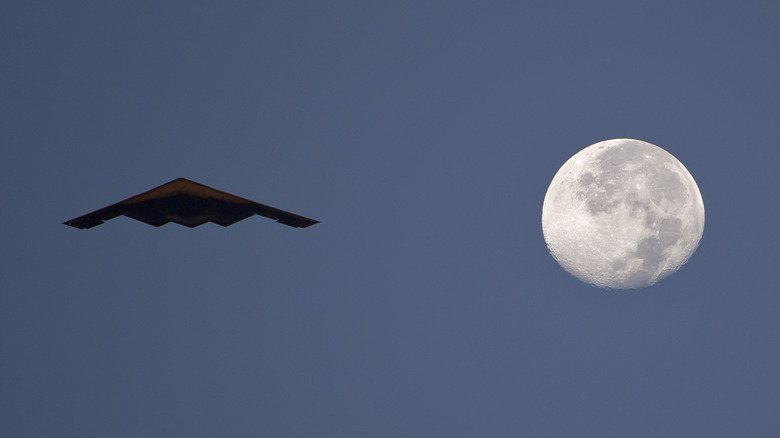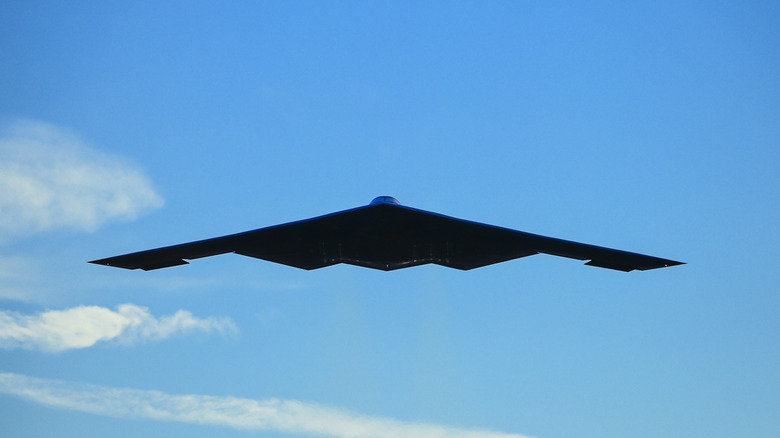Here's How Far A B-2 Bomber Can Fly Without Refueling
The B-2 Bomber is one of the most iconic aircraft in U.S. military history. Lauded for its stealth capabilities, the B-2 Bomber is a long-range, all-altitude heavy bomber hailed for its ability to bypass air defenses. As such, the Northrop Grumman-manufactured bomber is the United States' go-to whenever it needs to conduct an attack deep within enemy airspace. Take, for instance, the U.S. bombardment of Iranian facilities on June 21, 2025, when seven B-2 bombers dropped 14 30,000-pound bunker buster bombs on three underground Iranian nuclear sites.
In what is now known as the largest strike in B-2 Bomber history, the U.S. targeted the Fordo, Natanz, and Isfahan nuclear facilities without Iran ever detecting the group of American bombers, according to U.S. officials — a major testament to the B-2's superior stealth capabilities. This, of course, has been the norm since the jet's debut, with the B-2 playing a primary role in the U.S.' initial strikes in Serbia, Afghanistan, Iraq, Libya, and now Iran.
But what makes the B-2 one of America's best bombers? The Air Force attributes its effectiveness to a unique combination of "low observable" stealth features, advanced aerodynamics, extended range, and high payload capacity, which enable it to execute long-distance missions while evading advanced defense systems. Able to carry major payloads up to 6,000 nautical miles, the B-2 is integral to America's projection of strength abroad and has played a critical role in almost every major U.S. conflict since its inception.
Bombing is a game of distance
The B-2's ability to cover long ranges undetected makes it a unique weapon that greatly expands America's strategic playbook. With a range of 6,000 nautical miles without refueling, the B-2 is capable of flying from New York's JFK Airport to London Heathrow and back on a single tank. However, as is the case with its most recent sortie into Iranian airspace, refueling is a critical aspect of the B-2 bomber's various missions. A B-2 can extend its range to 10,000 nautical miles with a single refueling, more than enough to fly from New York to Sydney, Australia.
What sets the B-2 bomber apart is its ability to cover these distances without being detected. Constructed of Boeing's composite materials and coated with radar-absorbing paint, the B-2's unique flying wing design reduces the aircraft's infrared, acoustic, electromagnetic, visual, and radar signatures, enabling it to evade advanced air defense systems.
These advantages culminated in the opening of 2001's Operation Enduring Freedom, when the United States kicked off the war in Afghanistan with a fleet of B-2s executing the longest aerial combat mission on record. Taking off from their base in Missouri, six B-2s flew for a record 44 combat hours across the Pacific and through Pakistani airspace to deliver one of the most consequential bombing campaigns in modern U.S. history. Changing flight crews at the U.S.-U.K. joint airbase on Diego Garcia Island, located in the Indian Ocean, the mission lasted for 70 total hours, a major testament to the B-2's unparalleled range and stealth capabilities.
Anatomy of the B-2
Dubbed "Spirit," the B-2 is massive for a two-seater. It stands 17 feet high and 69 feet long, with a wingspan over 50 yards, and a max takeoff weight of 336,500 pounds. Four General Electric F118-GE-100 turbofan engines provide up to 69,200 pounds of thrust combined. Although slower than fighter jets like the F-22 Raptor, the B-2 Spirit can reach Mach 0.95 at 40,000 feet of altitude, topping out at roughly 630 mph.
The B-2 also holds the distinction of being the most expensive plane ever built on a per-aircraft basis, costing the United States a whopping $2.13 billion to manufacture. First flown in 1989 and delivered to the Air Force in 1993, the B-2 Spirit was designed to deliver nuclear payloads while evading the USSR's high-end air defense systems. With an initial order of 132 bombers, the B-2 is a testament to both the ingenuity and bloat of the Cold War-era arms race. Following the dissolution of the USSR, the B-2 project took on a different character, with the fleet capped at 21 (since reduced to 19) and shifting to non-nuclear bomb delivery.
The B-2 Spirit has played a key part in nearly every American conflict since its opening sortie, a 31-hour mission from Missouri's Whiteman Air Force Base to Kosovo and back. The conflict in Kosovo was a powerful announcement of the jet's arrival on the world stage. Over eight weeks, the B-2 bomber accounted for a third of the U.S.' successfully destroyed targets, despite flying on only 1% of its total missions. To this day, the B-2 remains critical to the American military playbook, executing its largest strike 35 years after its debut.


